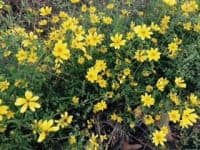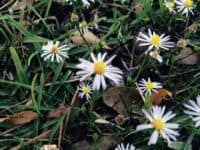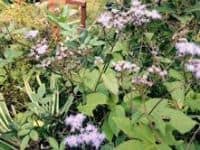
Wildflowers for Fall Plantings
Roadsides and meadows come alive with colors of wildflowers in September, October and November. Wildflowers for our area can be planted in Fall from late October through November and in spring during March and April.

The major colors of the fall wildflowers are golden yellow, purple, lavender, blue and pink. Particularly noticeable are tall wildflowers such as the golden narrow-leaved sunflower (Helianthus angustifolius), purple ironweed (Vernonia altissima), goldenrods (Solidago sp.), pinkish purple Joe-pye weed (Eupatorium fistulosum) and the striking red purple berries of the American beautyberry (Callicarpa Americana). Lower-growing wildflowers include white, lavender and pink such as asters (Asters sp.), blue mistflower (Eupatorium coelestinum), golden yellow sneezeweed (Helenium autumnale) and purple blazing star (Liatris sp.).
The home gardener can create the same effect in their own landscape by planting wild flowers in existing beds or letting wild plants sprout in place naturally. In some landscapes, natural-looking areas of wildflowers would be very appropriate. There are many good reasons for using wildflowers. Wildflowers are easy to maintain, but may need to be contained if an invasive species. Wildflowers can conserve energy once established as they require little water. They cost little compared to other plantings. They usually don’t need additional fertilizer to thrive as they tolerate dry or wet conditions. Wild flowers, especially native seeds can build a natural habitat which attracts native wildlife. We want to stay away from invasive seeds and plants.
Although the look you are trying to achieve may be spontaneous and natural, growing wildflowers requires planning. Look carefully at the growing conditions in the area that you want to plant with wildflowers. Use the wildflowers that will thrive under those conditions if you want to be successful. Notice how much sun the area receives. The texture of the soil and if the area tends to be damp or dry. Wildflowers can be grown in virtually every environment with proper placement and selection.

Open, dry, sunny areas are perfect for a field or meadow planting. Wildflower plantings in open areas along highways are typical of this type of planting. A shady woodland setting requires a different set of wildflower species. A meandering path through a wooded lot with wildflowers blooming on either side would be natural and beautiful. Boggy, damp areas can make appropriate wildflower gardens if you use the proper plants.
The easiest type of wildflower garden to establish is the open-field type grown from seed. Planting seeds in fall tends to produce the best results and should be done in late October through November. In our climate, most of the wildflowers will germinate in fall or early winter and grow through our relatively mild winter.
Select a sunny area to be planted and eliminate existing vegetation such as aggressive grasses by hand removal, or kill off the existing vegetation with a non-selective, systemic herbicide such as glyphosate (Killzall, Eraser, Roundup and other brands). Wildflower seeds will not germinate and grow as well in an area with established, thick vegetation.
After eliminating the existing vegetation, turn the soil with a shovel or tiller and rake it smooth. Generally, no fertilizer or soil amendments should be added to the soil during preparation. If this is not possible, you should at least mow down the dead vegetation low to the ground.

For a small planting, mix the wildflower seeds with sand or sandy soil and broadcast it evenly over the area by hand. For larger areas, mix the wildflower seeds with sand and apply it with a lawn seed spreader, which are readily available wherever gardening tools are sold. Make sure you use seeds or seed mixes of species that do well in our area. Provide good seed contact with the soil by pressing the seeds into the soil with a board or roller.
The seeds should be watered occasionally the first few weeks during the germination period if the weather is dry. Because we generally get regular rain from November to spring, watering once the seeds come up is usually not required.
Generally, wildflower seed mixes contain mostly annual and perennial species that bloom from seed the first year, so you can expect a glorious display next spring and early summer. Allow the wildflowers to complete their life cycle and drop seed before you mow the area. This is especially important for the annual wildflowers.
Other Fall blooming wildflowers for our area are; Cornflower, Common chicory, Dayflower, Queen Anne’s lace, Indian blanket or Firewheel, Rose Mallow, Salt Marsh-Mallow, Obedient Plant, Prairie Coneflower, Doorstep Flower, Creeping Spot Flower, Wood Sage and Tuber Vervain.
submitted by Karen Blackburn
